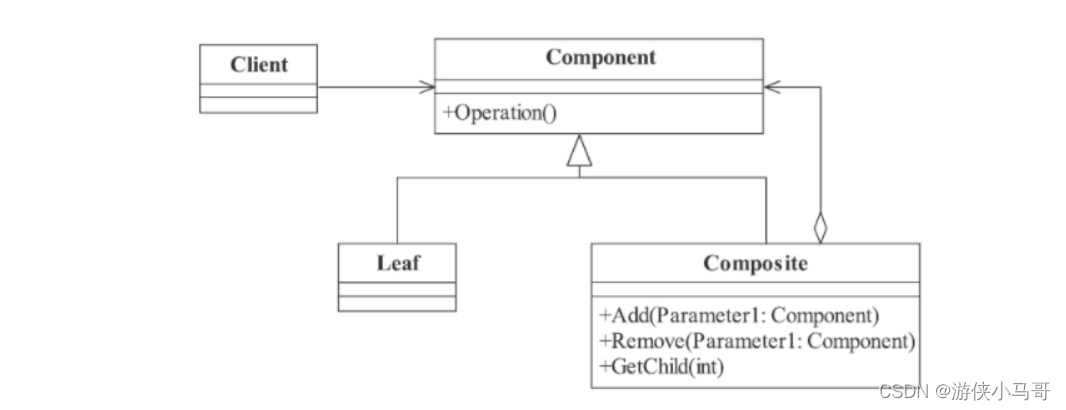设计模式之组合模式
组合模式
定义
组合模式(Composite Pattern)也叫合成模式,有时又叫做部分-整体模式(Part-Whole),主要是用来描述部分与整体的关系,其定义如下:
Compose objects into tree structures to represent part-whole hierarchies.Composite lets clients treat individual objects and compositions of objects uniformly.(将对象组合成树形结构以表示“部分-整体”的层次结构,使得用户对单个对象和组合对象的使用具有一致性。)
我们先来说说组合模式的几个角色:
- Component抽象构件角色
定义参加组合对象的共有方法和属性,可以定义一些默认的行为或属性,比如我们例子中的getInfo就封装到了抽象类中。
·Leaf叶子构件
叶子对象,其下再也没有其他的分支,也就是遍历的最小单位。
- Composite树枝构件
树枝对象,它的作用是组合树枝节点和叶子节点形成一个树形结构。
优缺点
优点
-
高层模块调用简单
一棵树形机构中的所有节点都是Component,局部和整体对调用者来说没有任何区别,也就是说,高层模块不必关心自己处理的是单个对象还是整个组合结构,简化了高层模块的代码。
-
节点自由增加
使用了组合模式后,我们可以看看,如果想增加一个树枝节点、树叶节点是不是都很容易,只要找到它的父节点就成,非常容易扩展,符合开闭原则,对以后的维护非常有利。
缺点
组合模式有一个非常明显的缺点,看到我们在场景类中的定义,提到树叶和树枝使用时的定义了吗?直接使用了实现类!这在面向接口编程上是很不恰当的,与依赖倒置原则冲突。
示例代码
- 抽象类组件
public abstract class Component {
public void doSomething() {
System.out.println("component do something");
}
}
-
组合类
public class Composite extends Component { // 构件容器 private List<Component> componentArrayList = new ArrayList<Component>(); // 增加一个叶子构件或树枝构件 public void add(Component component) { this.componentArrayList.add(component); } // 删除一个叶子构件或树枝构件 public void remove(Component component) { this.componentArrayList.remove(component); } // 获得分支下的所有叶子构件和树枝构件 public List<Component> getChildren() { return this.componentArrayList; } } -
叶子节点
public class Leaf extends Component { @Override public void doSomething() { System.out.println("leaf do something"); } } -
测试方法
@Test public void test() { // 创建一个根节点 Composite root = new Composite(); root.doSomething(); // 创建一个树枝构件 Composite branch = new Composite(); // 创建一个叶子节点 Leaf leaf = new Leaf(); // 建立整体 root.add(branch); branch.add(leaf); display(root); } // 通过递归遍历树 public static void display(Composite root) { for (Component c : root.getChildren()) { if (c instanceof Leaf) { // 叶子节点 c.doSomething(); } else { // 树枝节点 display((Composite)c); } } }
运行结果
component do something
leaf do something
示例代码地址
https://gitee.com/youxiaxiaomage/java-practices/tree/master/yxxmg-gof-sample/src/main/java/com/yxxmg/gof/structure/composite
本文来自互联网用户投稿,该文观点仅代表作者本人,不代表本站立场。本站仅提供信息存储空间服务,不拥有所有权,不承担相关法律责任。 如若内容造成侵权/违法违规/事实不符,请联系我的编程经验分享网邮箱:chenni525@qq.com进行投诉反馈,一经查实,立即删除!
- Python教程
- 深入理解 MySQL 中的 HAVING 关键字和聚合函数
- Qt之QChar编码(1)
- MyBatis入门基础篇
- 用Python脚本实现FFmpeg批量转换
- pytorch-模型预测概率值为负数
- 第7章-命令行操作基础
- (超详细)8-YOLOV5改进-添加EMA意力机制
- linux虚拟机网络不通,如何配置ip解决网络问题
- 模型部署flask学习篇(二)---- flask用户登录&用户管理
- Java stream 进阶版
- 【打卡】牛客网:BM68 矩阵的最小路径和
- 在x64上构建智能家居(home assistant)(二)(新版Debain12)连接Postgresql数据库
- 【TEE】AMD SEV- SNP和Intel TDX的概述
- 计算机组成原理复习6
